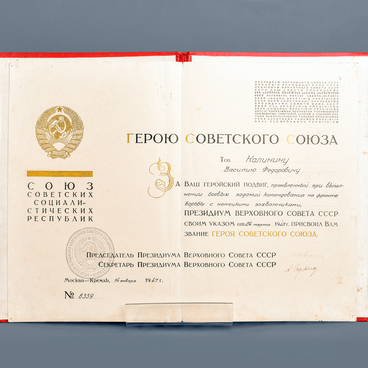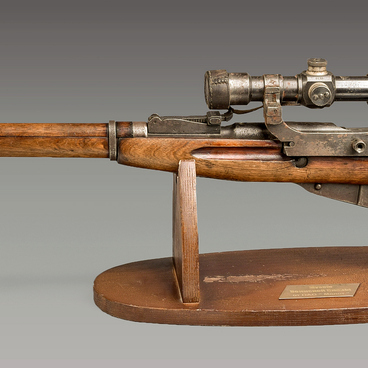The steel helmet in the German army replaced the pointed leather helmet — ‘Pikelhelm’. During the First World War, it became clear that Pikelhelm was not suitable for positional warfare, as it unmasked soldiers in the trench and made them an easy target for the enemy.
‘Stalhelm’ — translated from German as ‘steel helmet’ — has become one of the most recognizable attributes of Wehrmacht soldiers.
The helmet of the M-40 model presented in the exhibition is a modified version of the M-35 model. The modernization of the headdress was carried out in 1940: they simplified the process of creating ventilation holes, changed the composition of steel, replaced molybdenum with less scarce manganese and silicon.
Camouflage nets or covers were put on the steel helmet, which was covered with a mixture of dirt and sand, and branches and foliage were fixed — with the help of a rubber rim from the camera of a car tire.
For the soldiers to remain invisible, helmets were often painted with matte paint in darker shades of gray-green. Some soldiers — mostly fighters of reconnaissance units and snipers — masked stalhelms using the material of army raincoats with geometric camouflage.
The Wehrmacht used covers with a faint pattern in the form of geometric or blurry spots, and the SS troops used more diverse options: ornaments in the form of pea leaves, sycamore, oak, and palm trees. Camouflage was applied on one side of the camouflage fabric for spring and summer, on the other side — for autumn and winter.
At the same time, camouflage nets made of ropes, barbed wire, metal mesh for chicken coops became popular, which additionally secured improvised camouflage equipment.
Before the outbreak of hostilities, helmets were painted in a dull gray-green ‘feldgrau’ color, decals and identification emblems were applied to it. The ground forces on the right on the Stalhelm depicted the national heraldic shield in white, red and black sloping stripes, and on the left — the white and silver eagle of the Wehrmacht on a black field. Since 1940, only the decal of the Wehrmacht has remained, and the next model — M-42 — images were no longer applied.
‘Stalhelm’ — translated from German as ‘steel helmet’ — has become one of the most recognizable attributes of Wehrmacht soldiers.
The helmet of the M-40 model presented in the exhibition is a modified version of the M-35 model. The modernization of the headdress was carried out in 1940: they simplified the process of creating ventilation holes, changed the composition of steel, replaced molybdenum with less scarce manganese and silicon.
Camouflage nets or covers were put on the steel helmet, which was covered with a mixture of dirt and sand, and branches and foliage were fixed — with the help of a rubber rim from the camera of a car tire.
For the soldiers to remain invisible, helmets were often painted with matte paint in darker shades of gray-green. Some soldiers — mostly fighters of reconnaissance units and snipers — masked stalhelms using the material of army raincoats with geometric camouflage.
The Wehrmacht used covers with a faint pattern in the form of geometric or blurry spots, and the SS troops used more diverse options: ornaments in the form of pea leaves, sycamore, oak, and palm trees. Camouflage was applied on one side of the camouflage fabric for spring and summer, on the other side — for autumn and winter.
At the same time, camouflage nets made of ropes, barbed wire, metal mesh for chicken coops became popular, which additionally secured improvised camouflage equipment.
Before the outbreak of hostilities, helmets were painted in a dull gray-green ‘feldgrau’ color, decals and identification emblems were applied to it. The ground forces on the right on the Stalhelm depicted the national heraldic shield in white, red and black sloping stripes, and on the left — the white and silver eagle of the Wehrmacht on a black field. Since 1940, only the decal of the Wehrmacht has remained, and the next model — M-42 — images were no longer applied.



